Role of Precautionary Principle in Marine Biodiversity: A Report
VerifiedAdded on 2020/01/28
|59
|18010
|479
Report
AI Summary
This report delves into the crucial role of the precautionary principle in the conservation and sustainable use of marine biodiversity. It begins by defining marine biodiversity and the importance of its conservation, then outlines the research aim and objectives, which focus on identifying principles, assessing the precautionary principle's importance, and exploring associated challenges. The report traces the development of the precautionary principle, highlighting its origins in the Rio Declaration and its subsequent integration into international agreements like the CBD, UNCLOS, and MARPOL. It examines the principle's application in various contexts, including fisheries management, marine reserves, and coastal protection, while also addressing the challenges of implementation, such as translating principles into practice and managing uncertainty. The report explores the implications of the precautionary principle on research, management, and legal frameworks, emphasizing the need for proactive measures to protect marine ecosystems and ensure sustainable practices. The report covers multi-lateral and domestic agreements, the application of the precautionary principle in various cases, and challenges in its implementation, concluding with a comprehensive overview of the principle's significance in safeguarding marine biodiversity.

THE ROLE OF THE PRECAUTIONARY PRINCIPLE IN THE
CONSERVATION AND SUSTAINABLE USE OF MARINE
BIODIVERSITY
1
CONSERVATION AND SUSTAINABLE USE OF MARINE
BIODIVERSITY
1
Paraphrase This Document
Need a fresh take? Get an instant paraphrase of this document with our AI Paraphraser
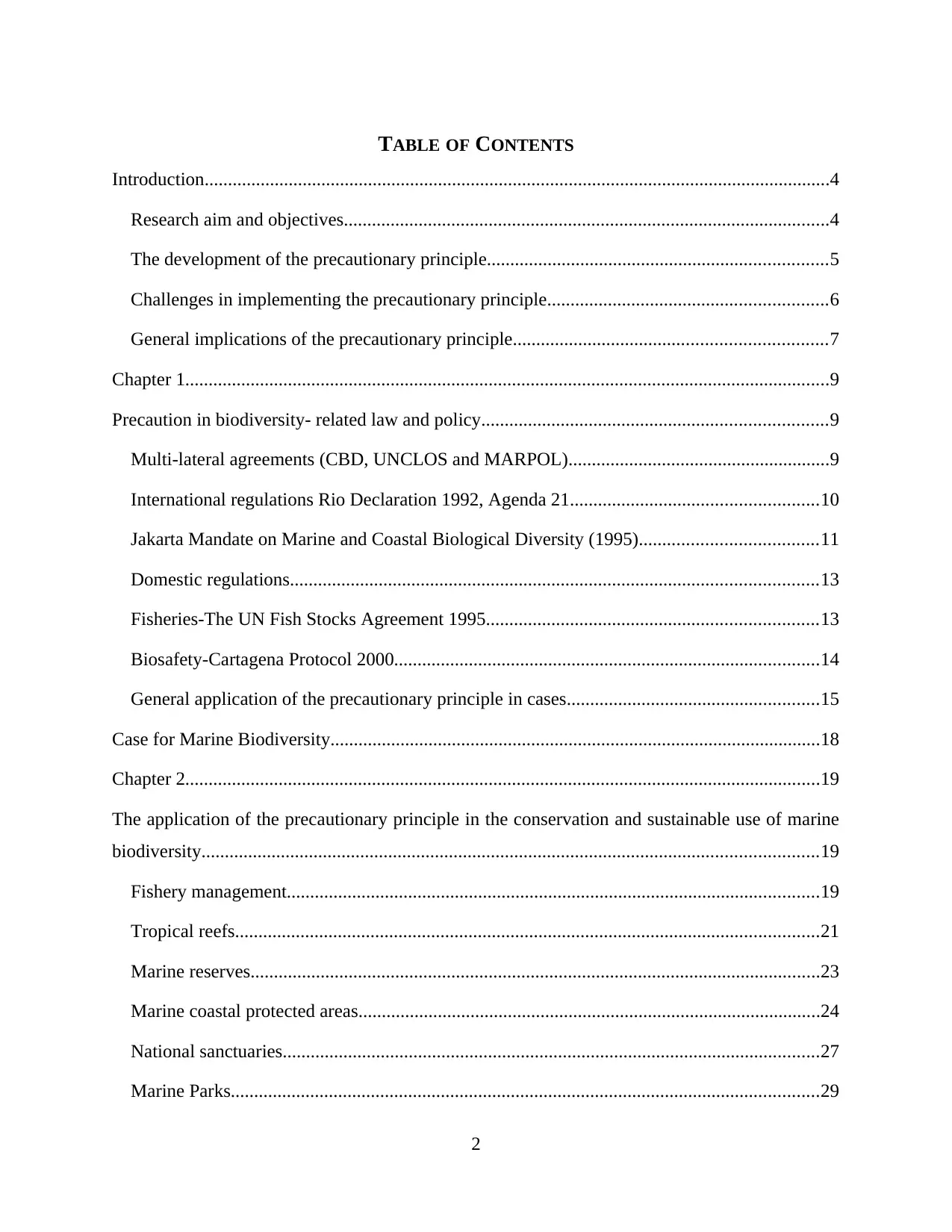
TABLE OF CONTENTS
Introduction......................................................................................................................................4
Research aim and objectives........................................................................................................4
The development of the precautionary principle.........................................................................5
Challenges in implementing the precautionary principle............................................................6
General implications of the precautionary principle...................................................................7
Chapter 1..........................................................................................................................................9
Precaution in biodiversity- related law and policy..........................................................................9
Multi-lateral agreements (CBD, UNCLOS and MARPOL)........................................................9
International regulations Rio Declaration 1992, Agenda 21.....................................................10
Jakarta Mandate on Marine and Coastal Biological Diversity (1995)......................................11
Domestic regulations.................................................................................................................13
Fisheries-The UN Fish Stocks Agreement 1995.......................................................................13
Biosafety-Cartagena Protocol 2000...........................................................................................14
General application of the precautionary principle in cases......................................................15
Case for Marine Biodiversity.........................................................................................................18
Chapter 2........................................................................................................................................19
The application of the precautionary principle in the conservation and sustainable use of marine
biodiversity....................................................................................................................................19
Fishery management..................................................................................................................19
Tropical reefs.............................................................................................................................21
Marine reserves..........................................................................................................................23
Marine coastal protected areas...................................................................................................24
National sanctuaries...................................................................................................................27
Marine Parks..............................................................................................................................29
2
Introduction......................................................................................................................................4
Research aim and objectives........................................................................................................4
The development of the precautionary principle.........................................................................5
Challenges in implementing the precautionary principle............................................................6
General implications of the precautionary principle...................................................................7
Chapter 1..........................................................................................................................................9
Precaution in biodiversity- related law and policy..........................................................................9
Multi-lateral agreements (CBD, UNCLOS and MARPOL)........................................................9
International regulations Rio Declaration 1992, Agenda 21.....................................................10
Jakarta Mandate on Marine and Coastal Biological Diversity (1995)......................................11
Domestic regulations.................................................................................................................13
Fisheries-The UN Fish Stocks Agreement 1995.......................................................................13
Biosafety-Cartagena Protocol 2000...........................................................................................14
General application of the precautionary principle in cases......................................................15
Case for Marine Biodiversity.........................................................................................................18
Chapter 2........................................................................................................................................19
The application of the precautionary principle in the conservation and sustainable use of marine
biodiversity....................................................................................................................................19
Fishery management..................................................................................................................19
Tropical reefs.............................................................................................................................21
Marine reserves..........................................................................................................................23
Marine coastal protected areas...................................................................................................24
National sanctuaries...................................................................................................................27
Marine Parks..............................................................................................................................29
2

Chapter 3........................................................................................................................................31
Challenges in implementing the precautionary principle in the conservation and sustainable use
of marine biodiversity....................................................................................................................31
Translating principles into practice...........................................................................................31
Extent and nature of uncertainty................................................................................................36
Nature of threat to biodiversity and living natural resources....................................................40
Chapter 4 Conclusion....................................................................................................................43
References......................................................................................................................................45
3
Challenges in implementing the precautionary principle in the conservation and sustainable use
of marine biodiversity....................................................................................................................31
Translating principles into practice...........................................................................................31
Extent and nature of uncertainty................................................................................................36
Nature of threat to biodiversity and living natural resources....................................................40
Chapter 4 Conclusion....................................................................................................................43
References......................................................................................................................................45
3
⊘ This is a preview!⊘
Do you want full access?
Subscribe today to unlock all pages.

Trusted by 1+ million students worldwide

INTRODUCTION
In general terms, biodiversity can be characterized as varieties and variabilities of life on
earth; whereas marine biodiversity shows different species present within ecosystem. The coast
along Western Pacific reflects the highest Marine biodiversity, on the other hand, temperature of
sea surface temperature has been witnessed to be highest in the oceans. Moreover, it has been
observed that bunch of these species is present in hotspots and has been increasing over the time.
However, it has been predicted that these trends may slow down in the coming times. The
present research work has been emphasizing on all the principles that can be applied for the
purpose of conserving marine biodiversity. Biodiversity is concerned with variety of living
beings existing in the form of animals or plants or organisms. In addition, theseare also the
essential component of nature which aids in proper survival of the human species. The quality of
biodiversity is dependent on conditions of weather along with the area of the region1.
Flora can be characterized as a cluster of different species of plants and presently, around
300,000 species have been included within this category. Similarly, fauna is the conglomerate of
different species of animals, which is inclusive of birds, molluscs, fish and mammals. Fast
changes in the environment causes mass extinctions; hence chief focus is required to be given
towards marine conservation. It can be said that marine resources are responsible for protecting
as well as preserving the eco-system both in oceans and sea. Thus, chief focus is laid on
restricting the detrimental impact which is caused on marine eco system by the humans, which in
turn also restores and preserves vulnerable marine species. Thus, as per the application of
principles, discussion has also been made regarding implications of precautionary principle on
research, management and legal aspects.
Further, key policy areas are also identified which aids in protecting the marine life.
Along with this, different areas are also discussed wherein biodiversity principles are required to
be adopted. Moreover, specific challenges are also defined that generally arise at the time of
applying principles in the areas of concern. Marine resource conservation is an active measure
1
Ronald Bailey, ‘The Precautionary Principle’s Challenge to Progress’ (2002)
<http://home.earthlink.net/~jhadler/prec.html> accessed on 1st March 2017.
4
In general terms, biodiversity can be characterized as varieties and variabilities of life on
earth; whereas marine biodiversity shows different species present within ecosystem. The coast
along Western Pacific reflects the highest Marine biodiversity, on the other hand, temperature of
sea surface temperature has been witnessed to be highest in the oceans. Moreover, it has been
observed that bunch of these species is present in hotspots and has been increasing over the time.
However, it has been predicted that these trends may slow down in the coming times. The
present research work has been emphasizing on all the principles that can be applied for the
purpose of conserving marine biodiversity. Biodiversity is concerned with variety of living
beings existing in the form of animals or plants or organisms. In addition, theseare also the
essential component of nature which aids in proper survival of the human species. The quality of
biodiversity is dependent on conditions of weather along with the area of the region1.
Flora can be characterized as a cluster of different species of plants and presently, around
300,000 species have been included within this category. Similarly, fauna is the conglomerate of
different species of animals, which is inclusive of birds, molluscs, fish and mammals. Fast
changes in the environment causes mass extinctions; hence chief focus is required to be given
towards marine conservation. It can be said that marine resources are responsible for protecting
as well as preserving the eco-system both in oceans and sea. Thus, chief focus is laid on
restricting the detrimental impact which is caused on marine eco system by the humans, which in
turn also restores and preserves vulnerable marine species. Thus, as per the application of
principles, discussion has also been made regarding implications of precautionary principle on
research, management and legal aspects.
Further, key policy areas are also identified which aids in protecting the marine life.
Along with this, different areas are also discussed wherein biodiversity principles are required to
be adopted. Moreover, specific challenges are also defined that generally arise at the time of
applying principles in the areas of concern. Marine resource conservation is an active measure
1
Ronald Bailey, ‘The Precautionary Principle’s Challenge to Progress’ (2002)
<http://home.earthlink.net/~jhadler/prec.html> accessed on 1st March 2017.
4
Paraphrase This Document
Need a fresh take? Get an instant paraphrase of this document with our AI Paraphraser
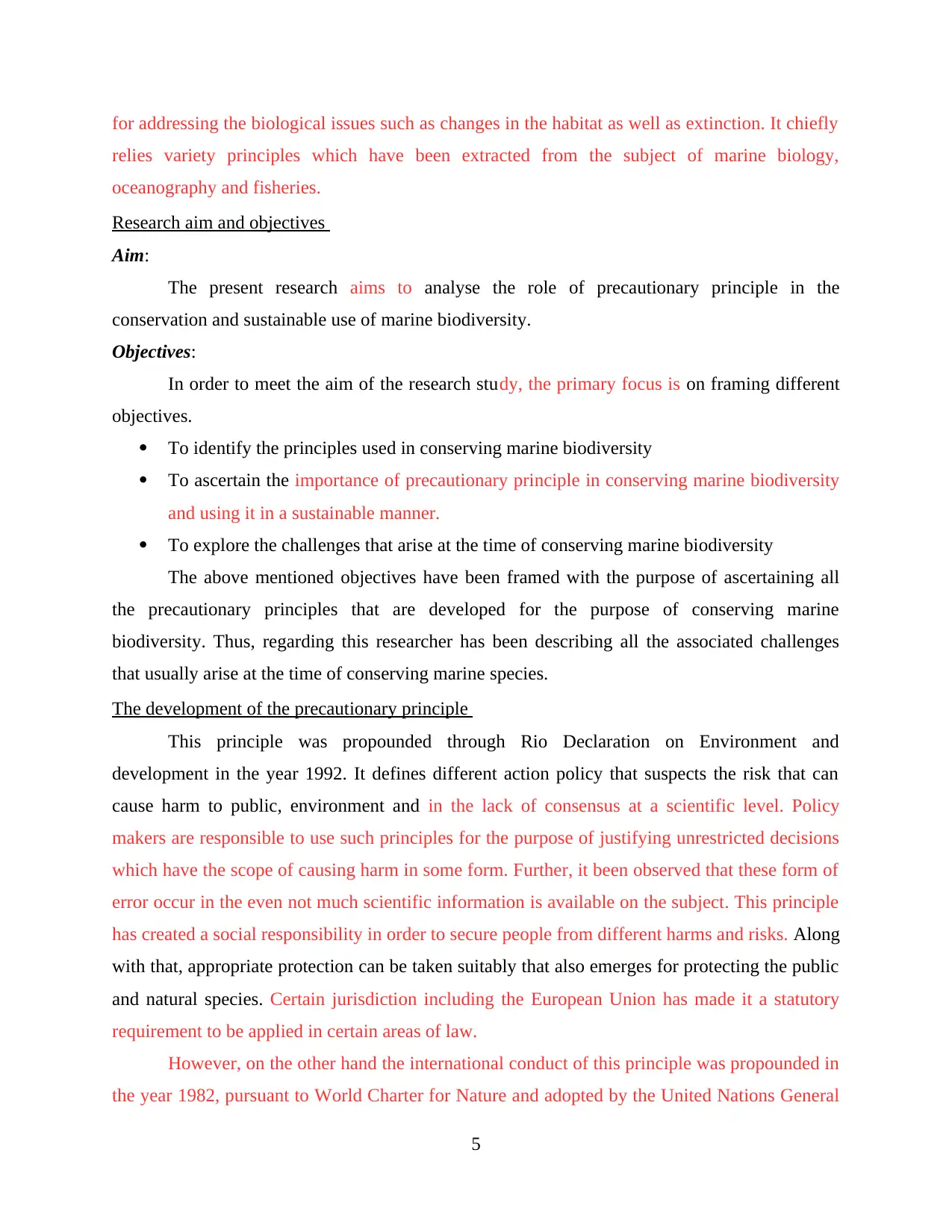
for addressing the biological issues such as changes in the habitat as well as extinction. It chiefly
relies variety principles which have been extracted from the subject of marine biology,
oceanography and fisheries.
Research aim and objectives
Aim:
The present research aims to analyse the role of precautionary principle in the
conservation and sustainable use of marine biodiversity.
Objectives:
In order to meet the aim of the research study, the primary focus is on framing different
objectives.
To identify the principles used in conserving marine biodiversity
To ascertain the importance of precautionary principle in conserving marine biodiversity
and using it in a sustainable manner.
To explore the challenges that arise at the time of conserving marine biodiversity
The above mentioned objectives have been framed with the purpose of ascertaining all
the precautionary principles that are developed for the purpose of conserving marine
biodiversity. Thus, regarding this researcher has been describing all the associated challenges
that usually arise at the time of conserving marine species.
The development of the precautionary principle
This principle was propounded through Rio Declaration on Environment and
development in the year 1992. It defines different action policy that suspects the risk that can
cause harm to public, environment and in the lack of consensus at a scientific level. Policy
makers are responsible to use such principles for the purpose of justifying unrestricted decisions
which have the scope of causing harm in some form. Further, it been observed that these form of
error occur in the even not much scientific information is available on the subject. This principle
has created a social responsibility in order to secure people from different harms and risks. Along
with that, appropriate protection can be taken suitably that also emerges for protecting the public
and natural species. Certain jurisdiction including the European Union has made it a statutory
requirement to be applied in certain areas of law.
However, on the other hand the international conduct of this principle was propounded in
the year 1982, pursuant to World Charter for Nature and adopted by the United Nations General
5
relies variety principles which have been extracted from the subject of marine biology,
oceanography and fisheries.
Research aim and objectives
Aim:
The present research aims to analyse the role of precautionary principle in the
conservation and sustainable use of marine biodiversity.
Objectives:
In order to meet the aim of the research study, the primary focus is on framing different
objectives.
To identify the principles used in conserving marine biodiversity
To ascertain the importance of precautionary principle in conserving marine biodiversity
and using it in a sustainable manner.
To explore the challenges that arise at the time of conserving marine biodiversity
The above mentioned objectives have been framed with the purpose of ascertaining all
the precautionary principles that are developed for the purpose of conserving marine
biodiversity. Thus, regarding this researcher has been describing all the associated challenges
that usually arise at the time of conserving marine species.
The development of the precautionary principle
This principle was propounded through Rio Declaration on Environment and
development in the year 1992. It defines different action policy that suspects the risk that can
cause harm to public, environment and in the lack of consensus at a scientific level. Policy
makers are responsible to use such principles for the purpose of justifying unrestricted decisions
which have the scope of causing harm in some form. Further, it been observed that these form of
error occur in the even not much scientific information is available on the subject. This principle
has created a social responsibility in order to secure people from different harms and risks. Along
with that, appropriate protection can be taken suitably that also emerges for protecting the public
and natural species. Certain jurisdiction including the European Union has made it a statutory
requirement to be applied in certain areas of law.
However, on the other hand the international conduct of this principle was propounded in
the year 1982, pursuant to World Charter for Nature and adopted by the United Nations General
5
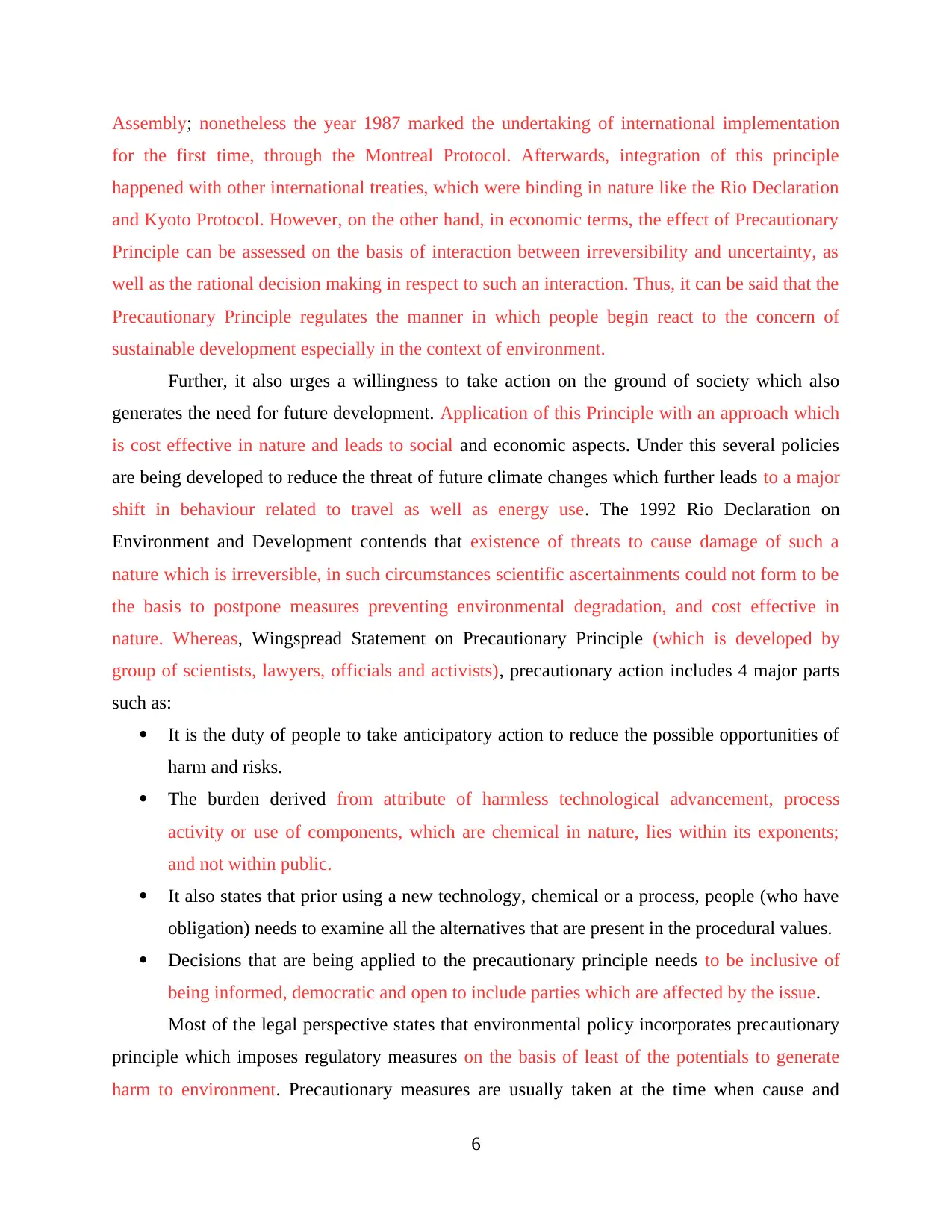
Assembly; nonetheless the year 1987 marked the undertaking of international implementation
for the first time, through the Montreal Protocol. Afterwards, integration of this principle
happened with other international treaties, which were binding in nature like the Rio Declaration
and Kyoto Protocol. However, on the other hand, in economic terms, the effect of Precautionary
Principle can be assessed on the basis of interaction between irreversibility and uncertainty, as
well as the rational decision making in respect to such an interaction. Thus, it can be said that the
Precautionary Principle regulates the manner in which people begin react to the concern of
sustainable development especially in the context of environment.
Further, it also urges a willingness to take action on the ground of society which also
generates the need for future development. Application of this Principle with an approach which
is cost effective in nature and leads to social and economic aspects. Under this several policies
are being developed to reduce the threat of future climate changes which further leads to a major
shift in behaviour related to travel as well as energy use. The 1992 Rio Declaration on
Environment and Development contends that existence of threats to cause damage of such a
nature which is irreversible, in such circumstances scientific ascertainments could not form to be
the basis to postpone measures preventing environmental degradation, and cost effective in
nature. Whereas, Wingspread Statement on Precautionary Principle (which is developed by
group of scientists, lawyers, officials and activists), precautionary action includes 4 major parts
such as:
It is the duty of people to take anticipatory action to reduce the possible opportunities of
harm and risks.
The burden derived from attribute of harmless technological advancement, process
activity or use of components, which are chemical in nature, lies within its exponents;
and not within public.
It also states that prior using a new technology, chemical or a process, people (who have
obligation) needs to examine all the alternatives that are present in the procedural values.
Decisions that are being applied to the precautionary principle needs to be inclusive of
being informed, democratic and open to include parties which are affected by the issue.
Most of the legal perspective states that environmental policy incorporates precautionary
principle which imposes regulatory measures on the basis of least of the potentials to generate
harm to environment. Precautionary measures are usually taken at the time when cause and
6
for the first time, through the Montreal Protocol. Afterwards, integration of this principle
happened with other international treaties, which were binding in nature like the Rio Declaration
and Kyoto Protocol. However, on the other hand, in economic terms, the effect of Precautionary
Principle can be assessed on the basis of interaction between irreversibility and uncertainty, as
well as the rational decision making in respect to such an interaction. Thus, it can be said that the
Precautionary Principle regulates the manner in which people begin react to the concern of
sustainable development especially in the context of environment.
Further, it also urges a willingness to take action on the ground of society which also
generates the need for future development. Application of this Principle with an approach which
is cost effective in nature and leads to social and economic aspects. Under this several policies
are being developed to reduce the threat of future climate changes which further leads to a major
shift in behaviour related to travel as well as energy use. The 1992 Rio Declaration on
Environment and Development contends that existence of threats to cause damage of such a
nature which is irreversible, in such circumstances scientific ascertainments could not form to be
the basis to postpone measures preventing environmental degradation, and cost effective in
nature. Whereas, Wingspread Statement on Precautionary Principle (which is developed by
group of scientists, lawyers, officials and activists), precautionary action includes 4 major parts
such as:
It is the duty of people to take anticipatory action to reduce the possible opportunities of
harm and risks.
The burden derived from attribute of harmless technological advancement, process
activity or use of components, which are chemical in nature, lies within its exponents;
and not within public.
It also states that prior using a new technology, chemical or a process, people (who have
obligation) needs to examine all the alternatives that are present in the procedural values.
Decisions that are being applied to the precautionary principle needs to be inclusive of
being informed, democratic and open to include parties which are affected by the issue.
Most of the legal perspective states that environmental policy incorporates precautionary
principle which imposes regulatory measures on the basis of least of the potentials to generate
harm to environment. Precautionary measures are usually taken at the time when cause and
6
⊘ This is a preview!⊘
Do you want full access?
Subscribe today to unlock all pages.

Trusted by 1+ million students worldwide
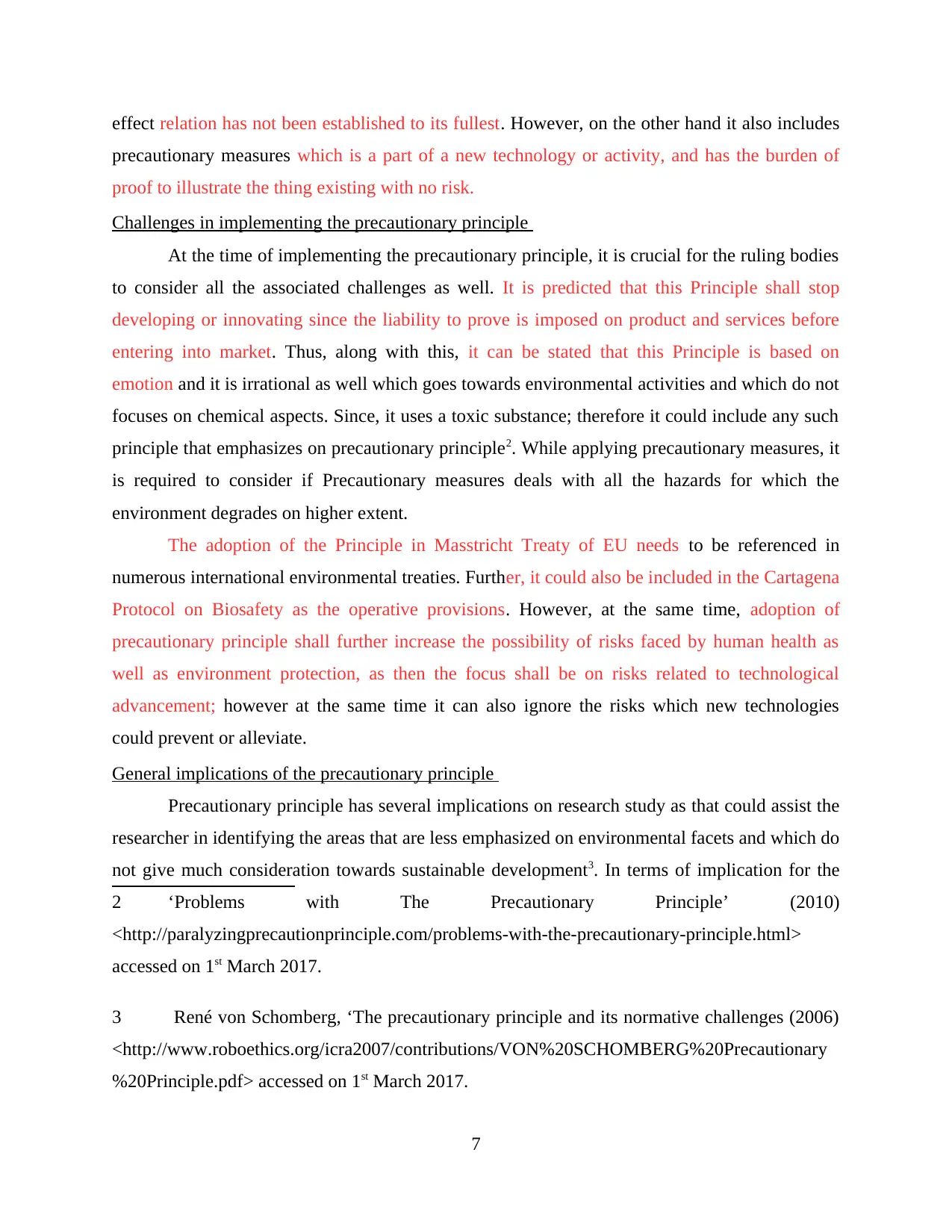
effect relation has not been established to its fullest. However, on the other hand it also includes
precautionary measures which is a part of a new technology or activity, and has the burden of
proof to illustrate the thing existing with no risk.
Challenges in implementing the precautionary principle
At the time of implementing the precautionary principle, it is crucial for the ruling bodies
to consider all the associated challenges as well. It is predicted that this Principle shall stop
developing or innovating since the liability to prove is imposed on product and services before
entering into market. Thus, along with this, it can be stated that this Principle is based on
emotion and it is irrational as well which goes towards environmental activities and which do not
focuses on chemical aspects. Since, it uses a toxic substance; therefore it could include any such
principle that emphasizes on precautionary principle2. While applying precautionary measures, it
is required to consider if Precautionary measures deals with all the hazards for which the
environment degrades on higher extent.
The adoption of the Principle in Masstricht Treaty of EU needs to be referenced in
numerous international environmental treaties. Further, it could also be included in the Cartagena
Protocol on Biosafety as the operative provisions. However, at the same time, adoption of
precautionary principle shall further increase the possibility of risks faced by human health as
well as environment protection, as then the focus shall be on risks related to technological
advancement; however at the same time it can also ignore the risks which new technologies
could prevent or alleviate.
General implications of the precautionary principle
Precautionary principle has several implications on research study as that could assist the
researcher in identifying the areas that are less emphasized on environmental facets and which do
not give much consideration towards sustainable development3. In terms of implication for the
2 ‘Problems with The Precautionary Principle’ (2010)
<http://paralyzingprecautionprinciple.com/problems-with-the-precautionary-principle.html>
accessed on 1st March 2017.
3 René von Schomberg, ‘The precautionary principle and its normative challenges (2006)
<http://www.roboethics.org/icra2007/contributions/VON%20SCHOMBERG%20Precautionary
%20Principle.pdf> accessed on 1st March 2017.
7
precautionary measures which is a part of a new technology or activity, and has the burden of
proof to illustrate the thing existing with no risk.
Challenges in implementing the precautionary principle
At the time of implementing the precautionary principle, it is crucial for the ruling bodies
to consider all the associated challenges as well. It is predicted that this Principle shall stop
developing or innovating since the liability to prove is imposed on product and services before
entering into market. Thus, along with this, it can be stated that this Principle is based on
emotion and it is irrational as well which goes towards environmental activities and which do not
focuses on chemical aspects. Since, it uses a toxic substance; therefore it could include any such
principle that emphasizes on precautionary principle2. While applying precautionary measures, it
is required to consider if Precautionary measures deals with all the hazards for which the
environment degrades on higher extent.
The adoption of the Principle in Masstricht Treaty of EU needs to be referenced in
numerous international environmental treaties. Further, it could also be included in the Cartagena
Protocol on Biosafety as the operative provisions. However, at the same time, adoption of
precautionary principle shall further increase the possibility of risks faced by human health as
well as environment protection, as then the focus shall be on risks related to technological
advancement; however at the same time it can also ignore the risks which new technologies
could prevent or alleviate.
General implications of the precautionary principle
Precautionary principle has several implications on research study as that could assist the
researcher in identifying the areas that are less emphasized on environmental facets and which do
not give much consideration towards sustainable development3. In terms of implication for the
2 ‘Problems with The Precautionary Principle’ (2010)
<http://paralyzingprecautionprinciple.com/problems-with-the-precautionary-principle.html>
accessed on 1st March 2017.
3 René von Schomberg, ‘The precautionary principle and its normative challenges (2006)
<http://www.roboethics.org/icra2007/contributions/VON%20SCHOMBERG%20Precautionary
%20Principle.pdf> accessed on 1st March 2017.
7
Paraphrase This Document
Need a fresh take? Get an instant paraphrase of this document with our AI Paraphraser
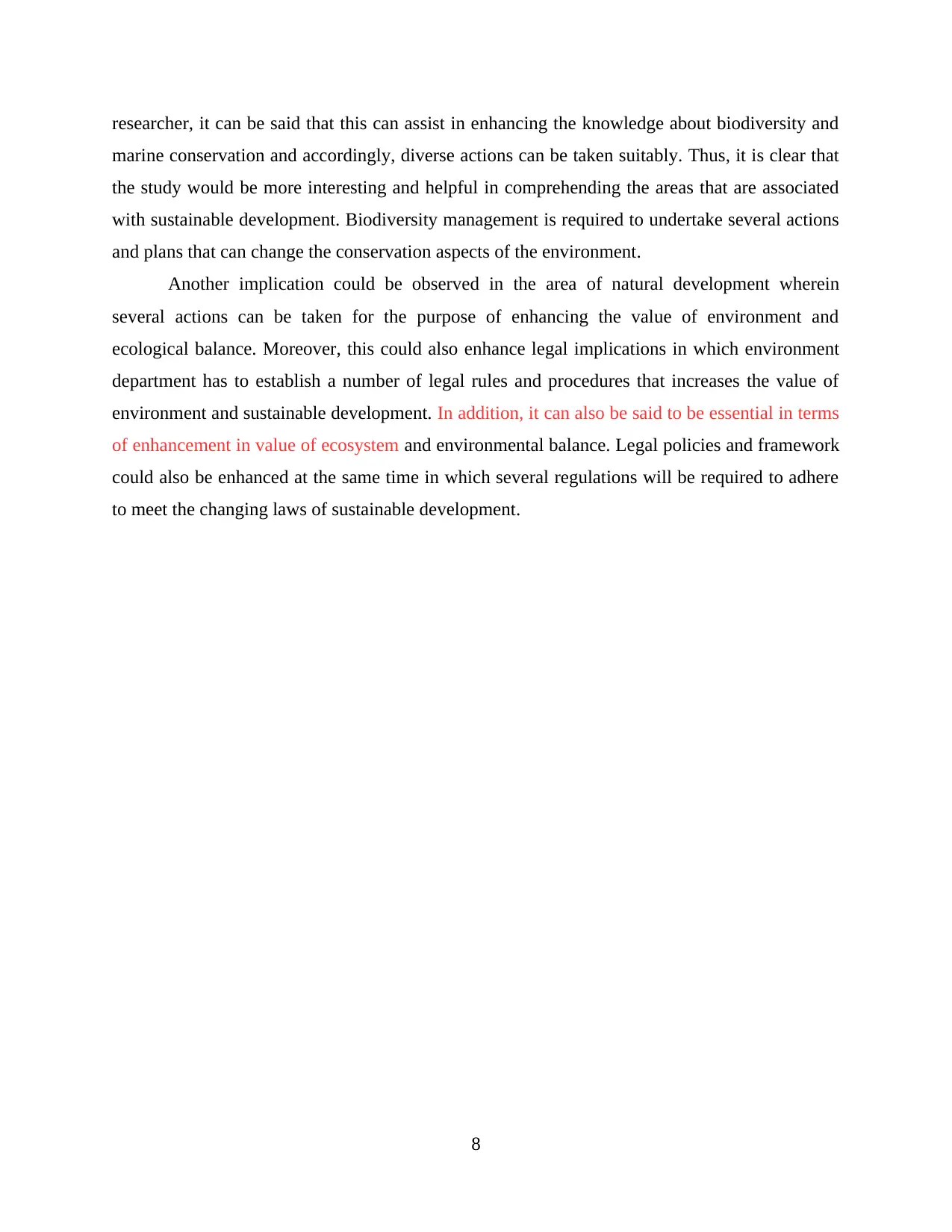
researcher, it can be said that this can assist in enhancing the knowledge about biodiversity and
marine conservation and accordingly, diverse actions can be taken suitably. Thus, it is clear that
the study would be more interesting and helpful in comprehending the areas that are associated
with sustainable development. Biodiversity management is required to undertake several actions
and plans that can change the conservation aspects of the environment.
Another implication could be observed in the area of natural development wherein
several actions can be taken for the purpose of enhancing the value of environment and
ecological balance. Moreover, this could also enhance legal implications in which environment
department has to establish a number of legal rules and procedures that increases the value of
environment and sustainable development. In addition, it can also be said to be essential in terms
of enhancement in value of ecosystem and environmental balance. Legal policies and framework
could also be enhanced at the same time in which several regulations will be required to adhere
to meet the changing laws of sustainable development.
8
marine conservation and accordingly, diverse actions can be taken suitably. Thus, it is clear that
the study would be more interesting and helpful in comprehending the areas that are associated
with sustainable development. Biodiversity management is required to undertake several actions
and plans that can change the conservation aspects of the environment.
Another implication could be observed in the area of natural development wherein
several actions can be taken for the purpose of enhancing the value of environment and
ecological balance. Moreover, this could also enhance legal implications in which environment
department has to establish a number of legal rules and procedures that increases the value of
environment and sustainable development. In addition, it can also be said to be essential in terms
of enhancement in value of ecosystem and environmental balance. Legal policies and framework
could also be enhanced at the same time in which several regulations will be required to adhere
to meet the changing laws of sustainable development.
8

CHAPTER 1
PRECAUTION IN BIODIVERSITY- RELATED LAW AND POLICY
Multi-lateral agreements (CBD, UNCLOS and MARPOL)
Multi- lateral agreements are binding agreement among countries and sometimes it also
builds agreement between regional groups of countries (especially among European Union).
Countries as well as regions who are the member of the international agreements are known as
“parties”. In connection to the same, Convention on Biological Diversity agreement can be
applied which came into force in the year 1994; however it became agreed in the year 1992.
Currently, it has more than 190 parties. The Convention on Biological Diversity primarily aims
to conservation of biological diversity and also to ensure sustainable utilization of the
components so that distribution of benefits can be undertaken in fair as well as equitable manner.
This is also essential for usage of genetic resources in optimum manner. There are basically two
major articles that are included for biotechnology and biosafety and that needs to be adhered.
Article 8 is about “In situ conservation of biodiversity”
The article contains an obligation which develops and maintains National Biosafety
Systems and this is also useful in establishing risks that are associated with living modified
organisms. Further, it is also analysed that the article seems to manage and regulate the risks
which arises in the form of release of living organism from biotechnology. This has a likely
impact on environmental aspects which has the capacity to influence the process of conservation
as well as sustainability in biological diversity. This also considers risks that are concerned with
human health and that changes the ways through which harm and environmental risks could be
reduced.
Article 19 is about “Handling biotechnology and distribution of its benefits”
It is stated that each of the contracting parties needs to take proper measures to participate
in activities related to biotechnological research undertaken by contractual parties which are
developed by developing countries. This also provides genetic resources to undertake the stated
research which are executable according to parties. Further, it is also mentioned that each of the
contracting party should adopt measures for promotion of priority access on an equitable basis in
accordance to parties. This is especially developed by emerging countries so as to benefit
biotechnologies that are based upon genetic resources.
9
PRECAUTION IN BIODIVERSITY- RELATED LAW AND POLICY
Multi-lateral agreements (CBD, UNCLOS and MARPOL)
Multi- lateral agreements are binding agreement among countries and sometimes it also
builds agreement between regional groups of countries (especially among European Union).
Countries as well as regions who are the member of the international agreements are known as
“parties”. In connection to the same, Convention on Biological Diversity agreement can be
applied which came into force in the year 1994; however it became agreed in the year 1992.
Currently, it has more than 190 parties. The Convention on Biological Diversity primarily aims
to conservation of biological diversity and also to ensure sustainable utilization of the
components so that distribution of benefits can be undertaken in fair as well as equitable manner.
This is also essential for usage of genetic resources in optimum manner. There are basically two
major articles that are included for biotechnology and biosafety and that needs to be adhered.
Article 8 is about “In situ conservation of biodiversity”
The article contains an obligation which develops and maintains National Biosafety
Systems and this is also useful in establishing risks that are associated with living modified
organisms. Further, it is also analysed that the article seems to manage and regulate the risks
which arises in the form of release of living organism from biotechnology. This has a likely
impact on environmental aspects which has the capacity to influence the process of conservation
as well as sustainability in biological diversity. This also considers risks that are concerned with
human health and that changes the ways through which harm and environmental risks could be
reduced.
Article 19 is about “Handling biotechnology and distribution of its benefits”
It is stated that each of the contracting parties needs to take proper measures to participate
in activities related to biotechnological research undertaken by contractual parties which are
developed by developing countries. This also provides genetic resources to undertake the stated
research which are executable according to parties. Further, it is also mentioned that each of the
contracting party should adopt measures for promotion of priority access on an equitable basis in
accordance to parties. This is especially developed by emerging countries so as to benefit
biotechnologies that are based upon genetic resources.
9
⊘ This is a preview!⊘
Do you want full access?
Subscribe today to unlock all pages.

Trusted by 1+ million students worldwide
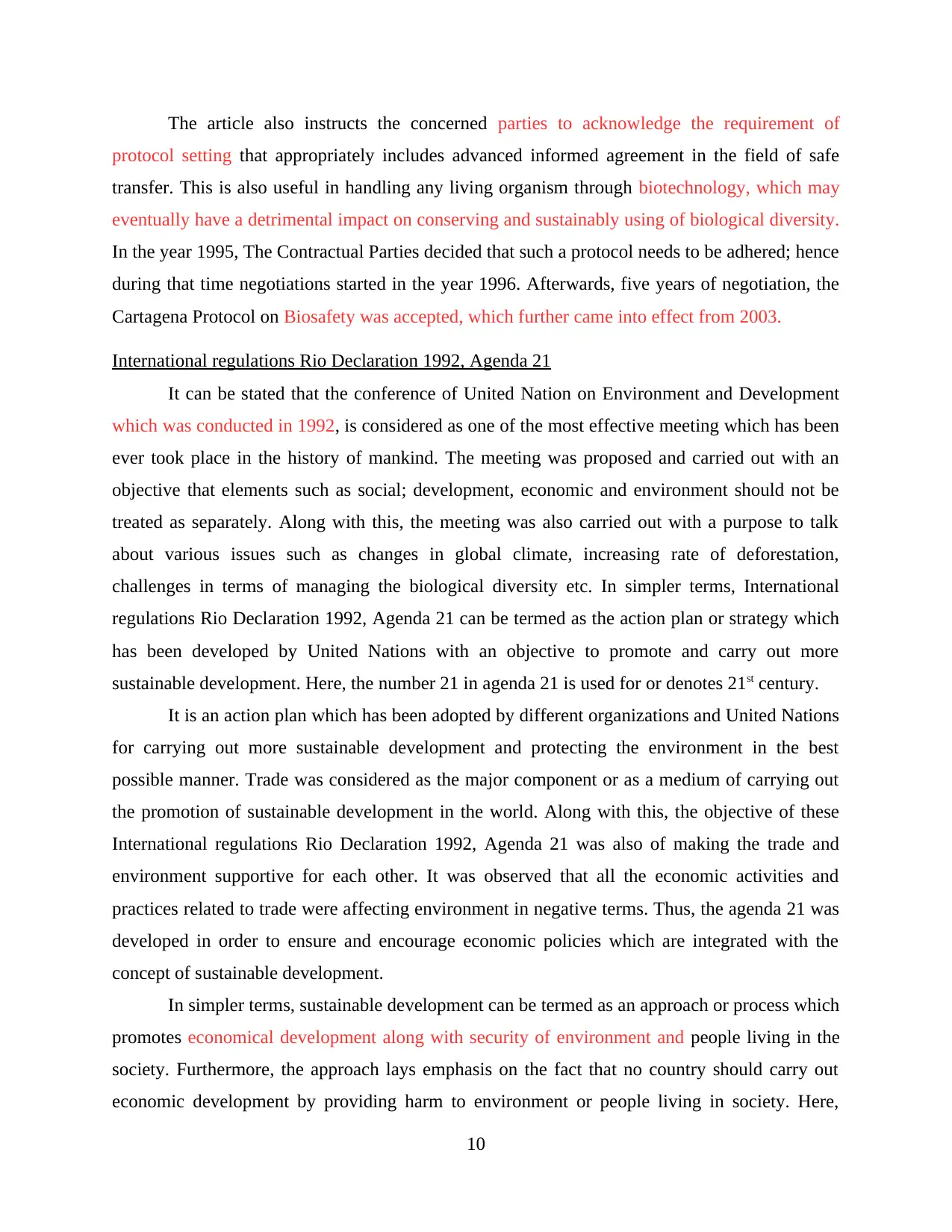
The article also instructs the concerned parties to acknowledge the requirement of
protocol setting that appropriately includes advanced informed agreement in the field of safe
transfer. This is also useful in handling any living organism through biotechnology, which may
eventually have a detrimental impact on conserving and sustainably using of biological diversity.
In the year 1995, The Contractual Parties decided that such a protocol needs to be adhered; hence
during that time negotiations started in the year 1996. Afterwards, five years of negotiation, the
Cartagena Protocol on Biosafety was accepted, which further came into effect from 2003.
International regulations Rio Declaration 1992, Agenda 21
It can be stated that the conference of United Nation on Environment and Development
which was conducted in 1992, is considered as one of the most effective meeting which has been
ever took place in the history of mankind. The meeting was proposed and carried out with an
objective that elements such as social; development, economic and environment should not be
treated as separately. Along with this, the meeting was also carried out with a purpose to talk
about various issues such as changes in global climate, increasing rate of deforestation,
challenges in terms of managing the biological diversity etc. In simpler terms, International
regulations Rio Declaration 1992, Agenda 21 can be termed as the action plan or strategy which
has been developed by United Nations with an objective to promote and carry out more
sustainable development. Here, the number 21 in agenda 21 is used for or denotes 21st century.
It is an action plan which has been adopted by different organizations and United Nations
for carrying out more sustainable development and protecting the environment in the best
possible manner. Trade was considered as the major component or as a medium of carrying out
the promotion of sustainable development in the world. Along with this, the objective of these
International regulations Rio Declaration 1992, Agenda 21 was also of making the trade and
environment supportive for each other. It was observed that all the economic activities and
practices related to trade were affecting environment in negative terms. Thus, the agenda 21 was
developed in order to ensure and encourage economic policies which are integrated with the
concept of sustainable development.
In simpler terms, sustainable development can be termed as an approach or process which
promotes economical development along with security of environment and people living in the
society. Furthermore, the approach lays emphasis on the fact that no country should carry out
economic development by providing harm to environment or people living in society. Here,
10
protocol setting that appropriately includes advanced informed agreement in the field of safe
transfer. This is also useful in handling any living organism through biotechnology, which may
eventually have a detrimental impact on conserving and sustainably using of biological diversity.
In the year 1995, The Contractual Parties decided that such a protocol needs to be adhered; hence
during that time negotiations started in the year 1996. Afterwards, five years of negotiation, the
Cartagena Protocol on Biosafety was accepted, which further came into effect from 2003.
International regulations Rio Declaration 1992, Agenda 21
It can be stated that the conference of United Nation on Environment and Development
which was conducted in 1992, is considered as one of the most effective meeting which has been
ever took place in the history of mankind. The meeting was proposed and carried out with an
objective that elements such as social; development, economic and environment should not be
treated as separately. Along with this, the meeting was also carried out with a purpose to talk
about various issues such as changes in global climate, increasing rate of deforestation,
challenges in terms of managing the biological diversity etc. In simpler terms, International
regulations Rio Declaration 1992, Agenda 21 can be termed as the action plan or strategy which
has been developed by United Nations with an objective to promote and carry out more
sustainable development. Here, the number 21 in agenda 21 is used for or denotes 21st century.
It is an action plan which has been adopted by different organizations and United Nations
for carrying out more sustainable development and protecting the environment in the best
possible manner. Trade was considered as the major component or as a medium of carrying out
the promotion of sustainable development in the world. Along with this, the objective of these
International regulations Rio Declaration 1992, Agenda 21 was also of making the trade and
environment supportive for each other. It was observed that all the economic activities and
practices related to trade were affecting environment in negative terms. Thus, the agenda 21 was
developed in order to ensure and encourage economic policies which are integrated with the
concept of sustainable development.
In simpler terms, sustainable development can be termed as an approach or process which
promotes economical development along with security of environment and people living in the
society. Furthermore, the approach lays emphasis on the fact that no country should carry out
economic development by providing harm to environment or people living in society. Here,
10
Paraphrase This Document
Need a fresh take? Get an instant paraphrase of this document with our AI Paraphraser

global partnership within countries was promoted in order to accelerate sustainable development
and deal with other issues related to climate change. International regulations Rio Declaration
1992, Agenda 21 can be termed as the product which has been derived from the Earth Summit.
However, it can be critically argued that International regulations Rio Declaration 1992,
Agenda 21 was also affirmed and several modifications has been carried out in the same. The
modifications or changes were carried out generally in the meetings of UN which were done
after the Rio declarations. Apart from this, Agenda 21 was also focused in combating from issues
such as poverty at international as well as national platform. The UN and other member
organizations developed effective strategies for providing people within potential opportunity to
earn a sustainable livelihood. In addition to this, Agenda 21 also laid emphasis on eliminating the
unsustainable patterns which are being used within process of producing and consuming
different goods as well as services.
Jakarta Mandate on Marine and Coastal Biological Diversity (1995)
It recognized the fact that biological diversity is formulated on the basis of different
variety of genes, ecosystems and species (which are most valuable resources at global level) that
also aids in sustaining and welfare of all humankind. In this respect, it can be said that the
Mandate is a global agreement which emphasizes on the vitality of marine as well as coastal
biological diversity4. It is also regarded as a part of the Ministerial Statement at the COP meeting
in Jakarta in the year 1995. This happened during effectuation of Convention of Biological
Diversity. The COP summit in Bratislava in 1998 also adopted the work programme. The
promotion and coordination undertaken by Secretariat of the Convention led to emergence of the
following principles:
4
‘The United Nations Agreement for the Implementation of the Provisions of the United Nations
Convention on the Law of the Sea of 10 December 1982 relating to the Conservation and
Management of Straddling Fish Stocks and Highly Migratory Fish Stocks (in force as
from 11 December 2001) Overview’ (2016)
<http://www.un.org/depts/los/convention_agreements/convention_overview_fish_stocks.
htm> accessed on 1st March 2017.
11
and deal with other issues related to climate change. International regulations Rio Declaration
1992, Agenda 21 can be termed as the product which has been derived from the Earth Summit.
However, it can be critically argued that International regulations Rio Declaration 1992,
Agenda 21 was also affirmed and several modifications has been carried out in the same. The
modifications or changes were carried out generally in the meetings of UN which were done
after the Rio declarations. Apart from this, Agenda 21 was also focused in combating from issues
such as poverty at international as well as national platform. The UN and other member
organizations developed effective strategies for providing people within potential opportunity to
earn a sustainable livelihood. In addition to this, Agenda 21 also laid emphasis on eliminating the
unsustainable patterns which are being used within process of producing and consuming
different goods as well as services.
Jakarta Mandate on Marine and Coastal Biological Diversity (1995)
It recognized the fact that biological diversity is formulated on the basis of different
variety of genes, ecosystems and species (which are most valuable resources at global level) that
also aids in sustaining and welfare of all humankind. In this respect, it can be said that the
Mandate is a global agreement which emphasizes on the vitality of marine as well as coastal
biological diversity4. It is also regarded as a part of the Ministerial Statement at the COP meeting
in Jakarta in the year 1995. This happened during effectuation of Convention of Biological
Diversity. The COP summit in Bratislava in 1998 also adopted the work programme. The
promotion and coordination undertaken by Secretariat of the Convention led to emergence of the
following principles:
4
‘The United Nations Agreement for the Implementation of the Provisions of the United Nations
Convention on the Law of the Sea of 10 December 1982 relating to the Conservation and
Management of Straddling Fish Stocks and Highly Migratory Fish Stocks (in force as
from 11 December 2001) Overview’ (2016)
<http://www.un.org/depts/los/convention_agreements/convention_overview_fish_stocks.
htm> accessed on 1st March 2017.
11
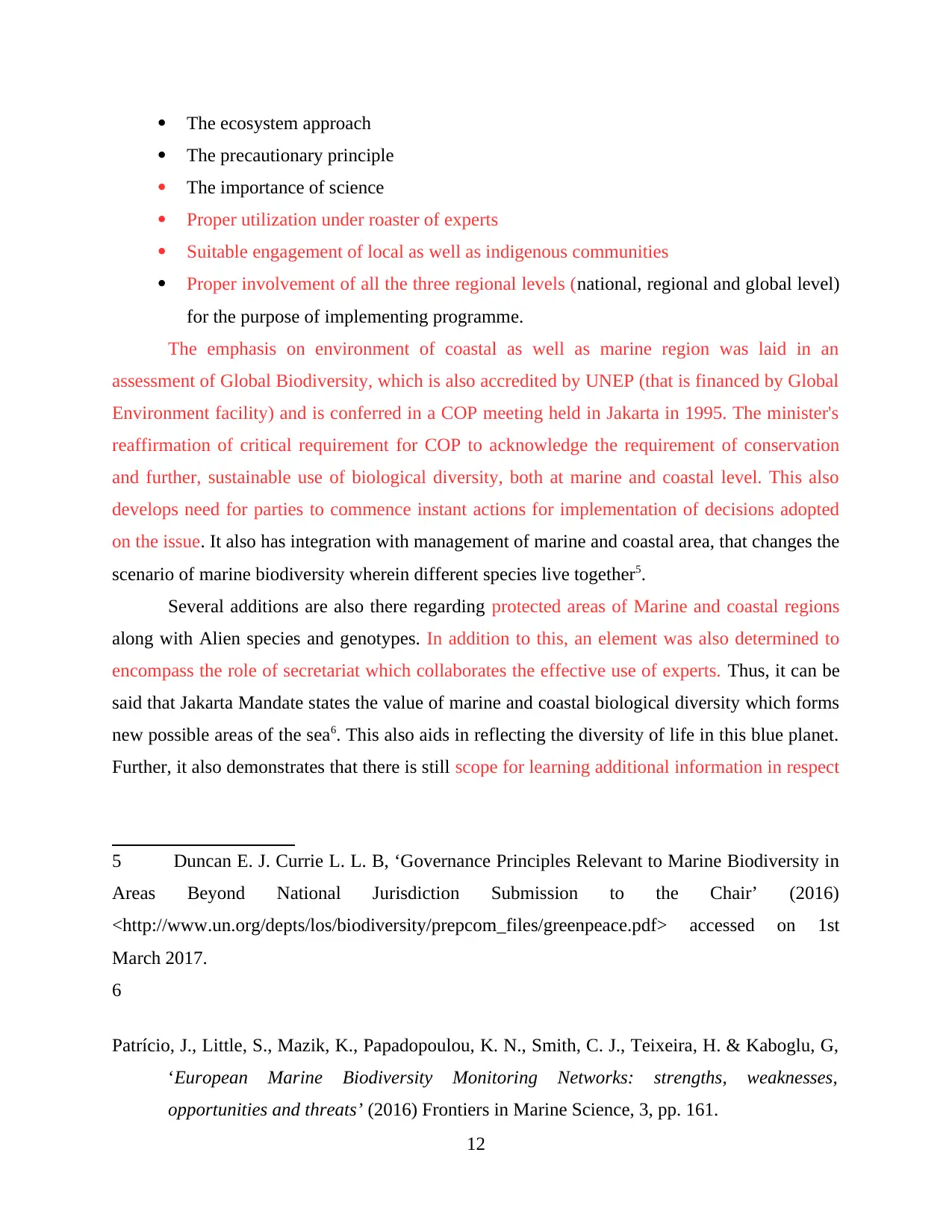
The ecosystem approach
The precautionary principle
The importance of science
Proper utilization under roaster of experts
Suitable engagement of local as well as indigenous communities
Proper involvement of all the three regional levels (national, regional and global level)
for the purpose of implementing programme.
The emphasis on environment of coastal as well as marine region was laid in an
assessment of Global Biodiversity, which is also accredited by UNEP (that is financed by Global
Environment facility) and is conferred in a COP meeting held in Jakarta in 1995. The minister's
reaffirmation of critical requirement for COP to acknowledge the requirement of conservation
and further, sustainable use of biological diversity, both at marine and coastal level. This also
develops need for parties to commence instant actions for implementation of decisions adopted
on the issue. It also has integration with management of marine and coastal area, that changes the
scenario of marine biodiversity wherein different species live together5.
Several additions are also there regarding protected areas of Marine and coastal regions
along with Alien species and genotypes. In addition to this, an element was also determined to
encompass the role of secretariat which collaborates the effective use of experts. Thus, it can be
said that Jakarta Mandate states the value of marine and coastal biological diversity which forms
new possible areas of the sea6. This also aids in reflecting the diversity of life in this blue planet.
Further, it also demonstrates that there is still scope for learning additional information in respect
5 Duncan E. J. Currie L. L. B, ‘Governance Principles Relevant to Marine Biodiversity in
Areas Beyond National Jurisdiction Submission to the Chair’ (2016)
<http://www.un.org/depts/los/biodiversity/prepcom_files/greenpeace.pdf> accessed on 1st
March 2017.
6
Patrício, J., Little, S., Mazik, K., Papadopoulou, K. N., Smith, C. J., Teixeira, H. & Kaboglu, G,
‘European Marine Biodiversity Monitoring Networks: strengths, weaknesses,
opportunities and threats’ (2016) Frontiers in Marine Science, 3, pp. 161.
12
The precautionary principle
The importance of science
Proper utilization under roaster of experts
Suitable engagement of local as well as indigenous communities
Proper involvement of all the three regional levels (national, regional and global level)
for the purpose of implementing programme.
The emphasis on environment of coastal as well as marine region was laid in an
assessment of Global Biodiversity, which is also accredited by UNEP (that is financed by Global
Environment facility) and is conferred in a COP meeting held in Jakarta in 1995. The minister's
reaffirmation of critical requirement for COP to acknowledge the requirement of conservation
and further, sustainable use of biological diversity, both at marine and coastal level. This also
develops need for parties to commence instant actions for implementation of decisions adopted
on the issue. It also has integration with management of marine and coastal area, that changes the
scenario of marine biodiversity wherein different species live together5.
Several additions are also there regarding protected areas of Marine and coastal regions
along with Alien species and genotypes. In addition to this, an element was also determined to
encompass the role of secretariat which collaborates the effective use of experts. Thus, it can be
said that Jakarta Mandate states the value of marine and coastal biological diversity which forms
new possible areas of the sea6. This also aids in reflecting the diversity of life in this blue planet.
Further, it also demonstrates that there is still scope for learning additional information in respect
5 Duncan E. J. Currie L. L. B, ‘Governance Principles Relevant to Marine Biodiversity in
Areas Beyond National Jurisdiction Submission to the Chair’ (2016)
<http://www.un.org/depts/los/biodiversity/prepcom_files/greenpeace.pdf> accessed on 1st
March 2017.
6
Patrício, J., Little, S., Mazik, K., Papadopoulou, K. N., Smith, C. J., Teixeira, H. & Kaboglu, G,
‘European Marine Biodiversity Monitoring Networks: strengths, weaknesses,
opportunities and threats’ (2016) Frontiers in Marine Science, 3, pp. 161.
12
⊘ This is a preview!⊘
Do you want full access?
Subscribe today to unlock all pages.

Trusted by 1+ million students worldwide
1 out of 59